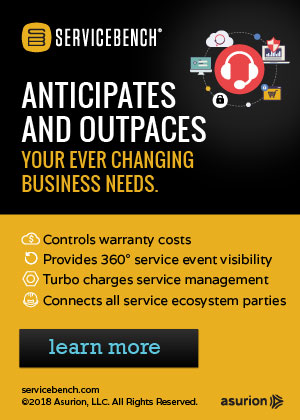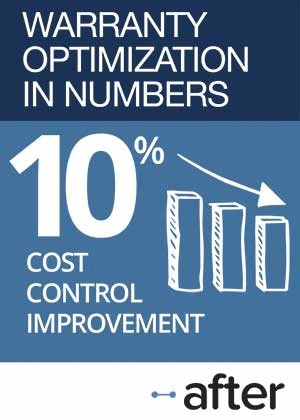Semiconductor Warranty Report:Unlike in most industries, with integrated circuits the production machinery generates most of the warranty cost while the actual products made by those machines generate less. However, the machinery makers have done a much better job of reducing their warranty expenses over the past decade.
In the warranty chain, there's the customer, the seller, the manufacturer, and the suppliers. In the last few weeks, we've shown how the customer-facing manufacturers end up paying more warranty expenses than the suppliers. For instance, with computer warranties, the Hewlett-Packards and Dells of the world paid about 80% of the total claims, while suppliers paid about 20%.
Now we've taken another step deeper, and we find just the opposite is true within the semiconductor industry. The companies making the actual integrated circuits and printed circuit boards pay only about 45% of the total claims. Their suppliers -- the companies that sell them the factory equipment that actually manufactures the devices -- pay the rest.
To reach this conclusion, we began by collecting warranty expense reports from 146 companies that manufacture semiconductors, integrated circuits and printed circuit boards, and the machinery that's used to make and/or test these devices. Within this group, however, we noticed that just the 19 companies that make the manufacturing equipment were generating more warranty expense than the 127 companies that were doing the actual manufacturing.
Suppliers Pay More Claims
In other words, the machines used to make the products generated more warranty expenses than the products the machines made. So we counted the expenses in three different ways: for all 146 companies together, and then separately for the 127 device makers versus the 19 manufacturing equipment makers.
In Figure 1 below, we're listing the annual totals for claims paid by the two separate groups over the past decade. As can be seen by the figures, the manufacturing equipment companies paid more than half the total in eight of the past 10 years.
Also, the annual warranty claims total for the equipment makers was down slightly in 2012, but was down by a whopping -24% for the device makers. And that, in turn, means that the equipment makers paid the highest share of the industry's total claims since 2007: more than 59% of the $625 million total.
Figure 1
Semiconductor & Printed Circuit Board Warranties
Claims Paid by U.S.-based Companies
(in US$ millions, 2003-2012)
Ordinarily, the likely reason for such a massive decline would be a drop in sales. But device sales revenue was actually up slightly in 2012. Manufacturing equipment revenue was down by -18%, thanks to big declines by Applied Materials Inc. (-17%) and Brooks Automation Inc. (-20%), among others. Lam Research Corp. saw sales climb, but much of that increase came with its acquisition of Novellus Systems Inc.
We should note that because there are so many companies that make semiconductors and integrated circuits in addition to other products, we pulled some companies into our list from other industrial categories. For instance, from the list of aerospace companies, we included Honeywell International Inc. and Newport Corp. From the list of medical equipment and scientific instrument companies, we included Agilent Technologies Inc. and Roper Industries Inc., among others. And we also drew select companies from the telecom equipment, building materials, and appliance manufacturers lists.
However, the only one among them to see a large drop in claims was Honeywell, and its 2011-to-2012 decline was only $37 million. So that's not enough to account for the $80 million decline in the category in Figure 1.
Accruals Also Fall
There was also a drop in 2012 accruals, as can be seen in Figure 2. However, this drop was more pronounced on the manufacturing equipment side. The 2011-to-2012 decline for the equipment makers was -$96 million or -24%, while the annual decline for the device makers was -$27 million or -10%.
Figure 2
Semiconductor & Printed Circuit Board Warranties
Accruals Made by U.S.-based Companies
(in US$ millions, 2003-2012)
Applied Materials cut its accruals by -$63 million in calendar 2012. But this was partially offset by big increases in accruals by Lam Research, Agilent Technologies, and First Solar Inc. But again, the Lam Research increase was driven primarily by its acquisition of Novellus.
There does appear to be some semblance of a lag time between the suppliers and their customers, however. For instance, the device makers saw claims peak in 2010, while their accruals peaked in 2008. For the companies supplying them with capital equipment, claims peaked in 2008 while accruals peaked in 2006. That would put the lag time between the suppliers and their customers at two years.
Warranty Reserves Decrease
Our third warranty metric is the balance in the warranty reserve fund. It's calculated at the end of each year by adding accruals and subtracting claims payments, and then by adjusting for other factors such as foreign exchange fluctuations.
In Figure 3, we can see a -$54 million decrease in the industry's total reserves in 2012, driven by a -$71 million decrease in the equipment makers' combined balance, but offset somewhat by a $17 million increase in the device makers' combined balance.
Figure 3
Semiconductor & Printed Circuit Board Warranties
Reserves Held by U.S.-based Companies
(in US$ millions, 2003-2012)
This time, the device makers are showing their highest balance ever in 2012, up 3% from their year-ending total in 2011. But the equipment makers saw their warranty reserve balance peak in 2007, with their 2012 balance ending up as the second-lowest level of the past decade.
Part of that can be explained by their consistent record of cost-cutting. Yes, the capital equipment makers pay more warranty cost, but they've also done the most to reduce their expenses.
Shifting Warranty Costs to Suppliers?
In Figures 4 and 5 we're comparing the data in Figures 1 and 2 to each industry sector's product revenue. The device makers have much more revenue than their equipment suppliers. And if we were to add in product revenues from companies such as Intel Corp. and Texas Instruments Inc., which say their warranty expenses are so slight as to be immaterial, this ratio would be even more pronounced.
In Figure 4, however, we're including the revenue of just the companies that also report warranty expenses. There is a great deal of up-and-down oscillations, which is probably tied to the fiscal years of some of the biggest warranty providers. However, keep in mind that the vertical scale is stretched to better show the trend, which is downwards over the decade.
Figure 4
Semiconductor & PC Board Manufacturers
Average Warranty Claims & Accrual Rates
(as a % of product sales, 2003-2012)
In fact, the lowest claims and accrual rates seen in the past decade both occurred in the third quarter of 2012, when both the industry's claims and accrual rates fell to just above 0.5% of revenue. Both were back above 0.7% by the fourth quarter, but that low water mark still stands. Notice also that the low water marks from previous years form their own downward trend line.
Strong Downward Trend in Expense Rates
The downward trend, however, is almost totally due to the efforts of the capital equipment makers. In Figure 5, we've separated them again, into two groups, comprised of 127 device makers and 19 manufacturing equipment makers, respectively.
Figure 5
Semiconductor & PC Board Manufacturers
Average Warranty Claims & Accrual Rates
Manufacturing Equipment vs. Chips & PCBs
(as a % of product sales, 2003-2012)
This time, it's easy to see where the decline is coming from. The equipment makers are at the top, and the device makers are at the bottom. It looks similar to the pattern seen in the automotive industry, except there the roles are reversed. There, it's the auto OEMs that start out with claims and accrual rates around three percent, while their suppliers start out around 0.5%. Here, the suppliers start high and end low, while their customers start low and stay about the same.
One way to measure this is to look at the gap between the two pairs of claims and accrual rates. From 2003 to 2007, the gap between the pairs averaged 1.7%. In 2008 and 2009, the equipment makers saw a spike in their claims rates caused by a recessionary decline in sales, so the gap widened. But then in the first quarter of 2010, the claims rates of the two groups almost met, with only a tenth of a percentage point of space between them.
The equipment makers have seen their average claims rate rise since then, so the gap has gone back to around 1.1% over the past three years. But notice the progress the equipment makers have made, cutting both their claims and accrual rates in half over the past decade. In contrast, the device makers have cut their claims and accrual rates from around 0.7% or 0.8% to around 0.4% or 0.5% over the same time period.
Warranty Claims "Market Shares"
Finally, we wanted to show some big changes in the industry on one single chart, by taking the claims payment data from Figure 1 and plotting it in terms of "market share" for the top dozen warranty providers. In Figure 6, the claims data is expressed as a percentage of 100% for each of the 12 companies.
Figure 6
Semiconductor & PC Board Manufacturers
Claims Paid per Year
(as a % share of the total in Figure 1)
Notice that over the course of the decade, the "market share" of the largest warranty provider in this sector, Applied Materials, has remained fairly constant at 22%, plus or minus 5%. However, that's not the case for all the companies highlighted.
Nvidia, for instance, accounted for 4% or 5% of the total claims payments from 2003 to 2008. But then it went very wrong for the company, with its share of the claims payments swelling to 29% in 2009 and 30% in 2010. but now things have returned more or less to normal, and its share is back down to 6%.
Rising Solar Share
The makers of solar panels in general, and First Solar in specific, have seen their share of the market grow as well. It's even more pronounced on the accrual side, where the companies are currently setting aside funds they may not need to spend for 10 or even 20 years. But even now, the solar companies are beginning to show up as major warranty providers. We'll circle back to survey this trend in more detail in a future report on power generating equipment warranties.
Finally, we placed the "market shares" of Lam Research and Novellus next to each other so we could show how the now-merged companies fit together in terms of warranty expenses. Novellus has cut its warranty costs tremendously from the days when it regularly paid out more than five percent of its revenue to satisfy claims. During one particularly bad quarter at the end of 2008, both its claims and accrual rates were over 15%.
Meanwhile, Lam Research has grown its business and its warranty costs more or less in proportion to one another, keeping both its claims and accrual rates close to two percent, except for one brief manufacturing excursion that took place in late 2008 and early 2009. Combined with Novellus, it's likely to remain the second-largest warranty provider in the semiconductor industry, with KLA-Tencor, AMD and First Solar jousting for third, fourth and fifth place.
Tenth Annual Product Warranty Reports
As we begin to wrap up our annual survey of U.S.-based warranty providers, here are some links to the online editions of all the previous parts of this series:
|















